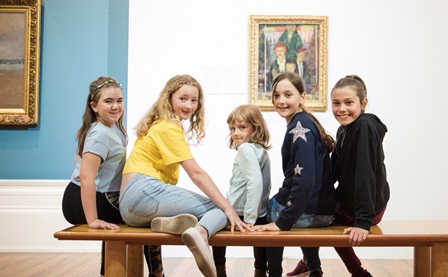Fashion & Textiles
Fashion
The Harris has a strong collection of women’s clothing and accessories from the 1800s to 1950s. Highlights include a Spitalfields silk dress from the 1740s and the dress in the painting ‘Pauline in the Yellow Dress’ by Sir James Gunn. A significant collection of Horrockses Fashions dresses from the 1940s to the 1970s is complemented by material from the company’s design archive.
The Harris has a wide range of men’s clothing and accessories from the 1790s to the 1880s, including rare examples of gentlemen’s clothing and servants’ livery from the early 1800s donated by the Hulton Family. Other significant areas of the collection are designer wear from the 1960s to modern day, including Vivienne Westwood and David Fielden.
The collection also has examples of farming and working dress from 1880s to 1950s, CC41 utility clothing and underwear, Quaker clothing and a quirky collection of fuzzy felt fashions associated with two portraits by Mabel Haythorn in the collection. Many garments have strong connections with Preston and were made or worn by local people. These include clothes associated with the Preston Guild, and a significant collection of South Asian dress from the 1990s.
Textiles
This collection includes flat works such as embroidery, lace, quilts and printed cottons. Local firms are represented, but much of the collection reflects textile’s status as a popular personal and creative activity, as well as developments in recent textile art. Highlights include a fragment of Coptic textile from around 600, and embroidery and samplers from the 1700s to 1800s. Quilts range from a military example from 1890s to the ‘Harris Quilt’ commissioned from Josephine Ratcliff in 1998. An interesting collection of post 1950s artist-designed fabrics includes William Gear, Shirley Craven, Althea McNish.
There are also 18 volumes of historic South Asian fabrics in The Textile Manufactures of India. You can view the complete collection of fabric samples, find out more about Forbes Watson and the books by visiting www.tmoi.org.uk
Fashion plates
The museum also holds a fine collection of over 2,000 unbound, hand-coloured fashion plates dating from the 1770s to the 1890s which have been taken from a variety of women’s periodicals. This collection can be viewed by appointment.
Click here to see highlights of our collection online at on Google Arts & Culture’s We Wear Culture
More of our costume and textiles collection
Date
Around 50 items from this collection are on display. Items not on display are in our stores and are available to view by appointment. Please email theharris@preston.gov.uk if you have a specific query.
Location
This collection is on display in the Costume Gallery on the 2nd floor.
Cost: free
This collection is free to visit
Exploring Fashion & Textiles
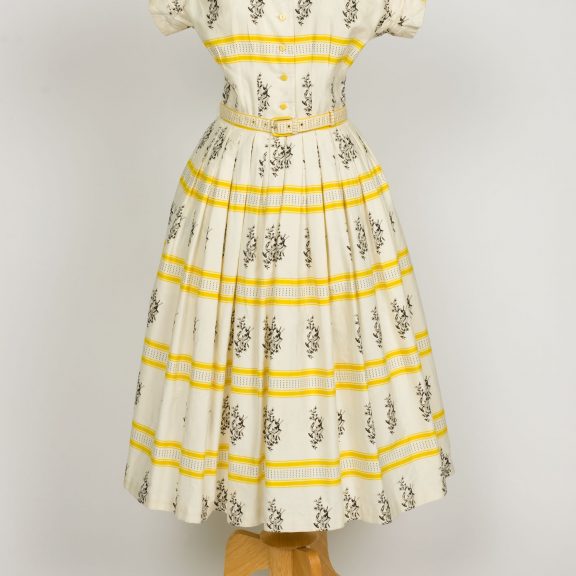
Yellow and white musical instrument dress
Date: c1950s
Object number: 1999.562.1
Designer: Horrockses Fashions
Cotton shirtwaister dresses like this look simple from a distance. However, on closer inspection the dress features some classic Horrockses Fashions designs. From the banded stripes in white and yellow, geometric dots to an illustrated black musical instrument print. The small yellow buttons and matching belt pull the look together combining smartness, fun and practicality!
The style is typical of the kind of dresses that were so popular with Horrockses Fashions’ customers as they were suitable for almost any daytime occasion. This dress was made in the 1950s and was purchased by the donor from a shop in Preston.
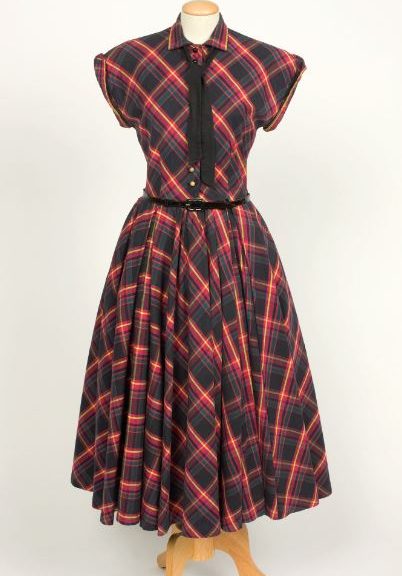
Tartan dress
Date: 1950s
Object number: 1977.79.3
Designer: Horrockses Fashions
This unusual Horrockses Fashions day dress is an example of where the brand, famous for their stylish printed floral designs, occasionally deviated from their usual style. The collared tartan dress is made of cotton, instead of the more usual wool, and is patterned in the weave rather than by print. The tartan design has been brightened up by the use of colours such as yellow and fuchsia pink, making it a bit more exciting and less traditional.
The dress is also cut on the bias, a technique where the fabric is cut diagonally, and uses more fabric. This technique often means a dress will hang more delicately on the wearer, giving the dress a more interesting and flattering effect.
The attention to detail in the design and cut of this dress is what helped earn Horrockses Fashions their reputation in the 1950s where they gained in popularity. This particular dress was bought at Nottingham House on Fishergate in Preston by the donor and was donated to the Harris in the 1970s.
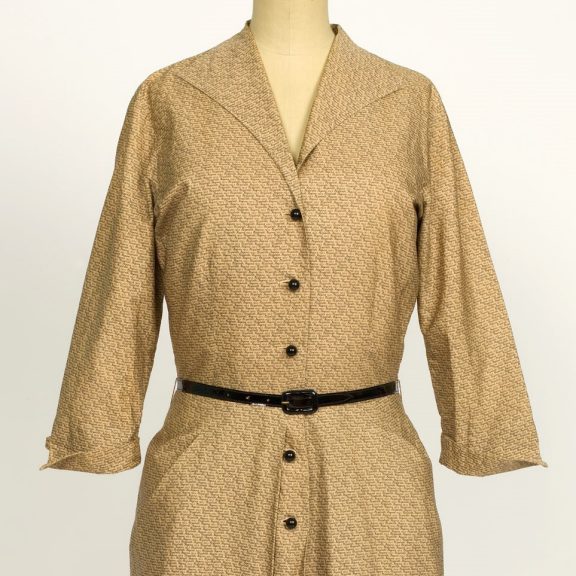
Elizabeth Regina 1953 dress
Date: 1952
Object number: 2004.11
Designer: Horrockses Fashions
This cinnamon brown Horrockses Fashions cotton shirtwaister dress was produced to commemorate the coronation of Queen Elizabeth II in 1953. The dense pattern is made up of the hand-written words ‘Elizabeth Regina 1953’ printed all over the fabric.
The small repeating letters and the spaces in-between form a fine pattern against the taupe ground colour. Lots of commemorative textiles such as tea towels were produced to mark the Queen’s coronation in 1953 but few are as sophisticated as this dress!
The dress was acquired directly from Horrockses Fashions at their London showroom by the donor who knew John Tullis, Horrockses senior in-house designer, which meant she able to buy the dress for a bargain cost price!
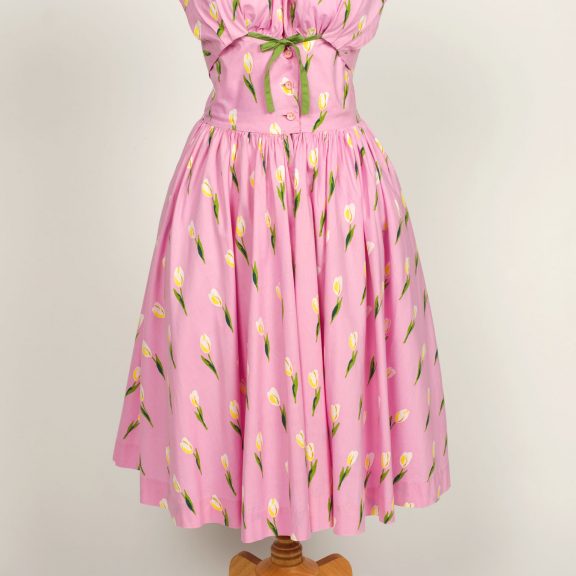
Pink tulip dress with matching bolero
Date: 1954
Object number: 2001.38
Artist: Horrockses Fashions
This pretty pink cotton halter neck sun dress is printed with a yellow and white tulip pattern, it also come with a matching bolero and belt.
The dress was designed by Joyce Badrocke, who was the in-house designer for Horrockses Fashions. This particular Horrockses fabric print in blue was chosen by Queen Elizabeth II for her 1953-4 tour of New Zealand. The design wouldn’t have been made available to the public until after she had worn it!
The donor purchased her version of the dress at Nottingham House on Fishergate in Preston in 1954 to wear for her honeymoon.

White and black honeycomb dress
Date: c1950s
Object number: 2010.128
Designer: Horrockses Fashions
This Horrockses Fashions printed dress with ruched bodice is made of white cotton with a black printed honeycomb net pattern and imitation lace design. It comes with a sleeveless jacket in a matching design.
The dress was worn by the donor in the 1960s and was bought for her by a family friend who went on regular shopping trips to London. The donor was brought up in Wirral but knew of the famous and well known Horrockses Fashions brand as her father was from Lancashire.
She would regularly wear the dress for nights out when attending dances in the Chester and Liverpool area to venues such as Quaintways, Clemences and Reeces and said she “always had a good time in this dress”.
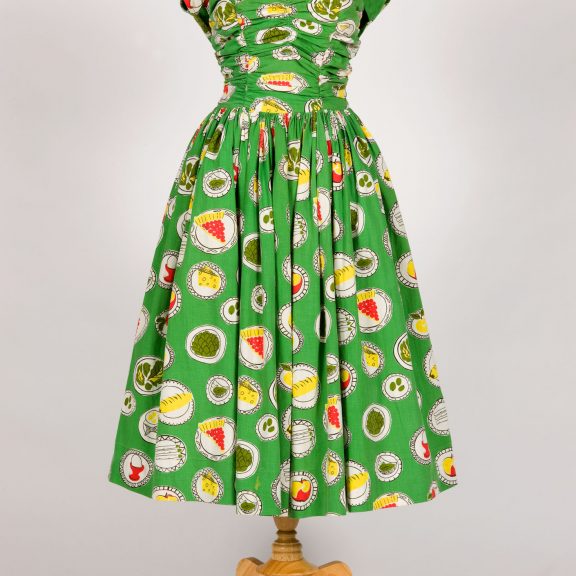
Green food print sun dress
Date: c1950s
Object number: 2001.37
Designer: Horrockses Fashions
Horrockses Fashions were famous for their floral dresses, but more unusual patterns were also part of the company’s repertoire.
This cotton sun dress with a rouched and boned bodice, full skirt and a matching sleeveless bolero jacket was worn in the early 1950s and purchased from a department store in St Anne’s.
It was designed and worn at a time when food rationing was still in place in Britain until the mid-1950s. The types of food illustrated include asparagus, quiche and artichoke, all of which must have appeared very exotic to people living off wartime rations. You can also spot other foods in the design including cherry pie, apples, cheese, asparagus and even a boiled egg!
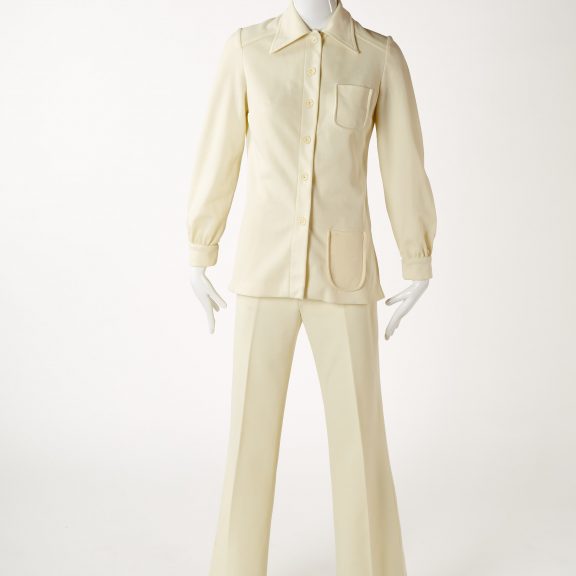
Cream trouser suit
Date: 1970s
Object number: 1993.85
Designer: Spinney
In the 1970s Bianca Jagger made the white trouser suit a fashion statement. Mrs Cheadle of Longton was rocking a similar look on nights out in Preston! Mrs Cheadle and her husband donated several examples of their 1970s clothes to the museum in the 1990s. This cream trouser suit John Travolta style outfit is by fashion label Spinney.
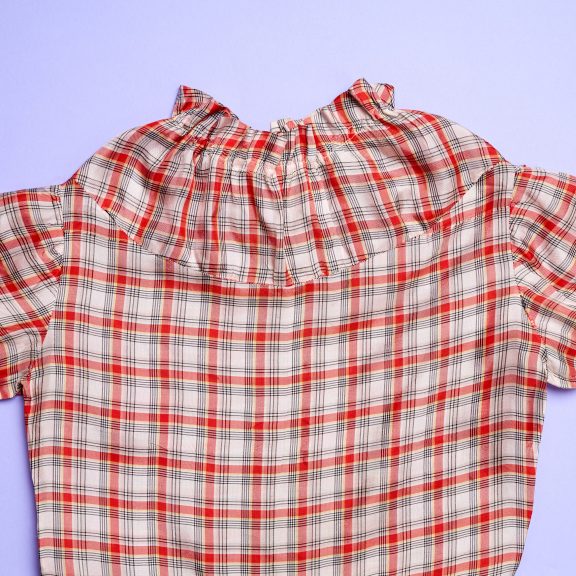
Handmade plaid dress
Made: Bolton
Date: 1934
Object number: 2015.521
This red plaid dress was handmade by Ruby Barden in the 1930s. Mrs Barden worked at Dick, Kerr’s in Preston and was a keen dressmaker. She used the backroom of the family home as her workspace to make clothes on her Singer Sewing Machine. She bought her fabrics from local markets and stored all them in the children’s bedroom. Her daughter said that this was her favourite dress and that she had been very proud to have made it herself, it comes with a matching jacket and shawl.
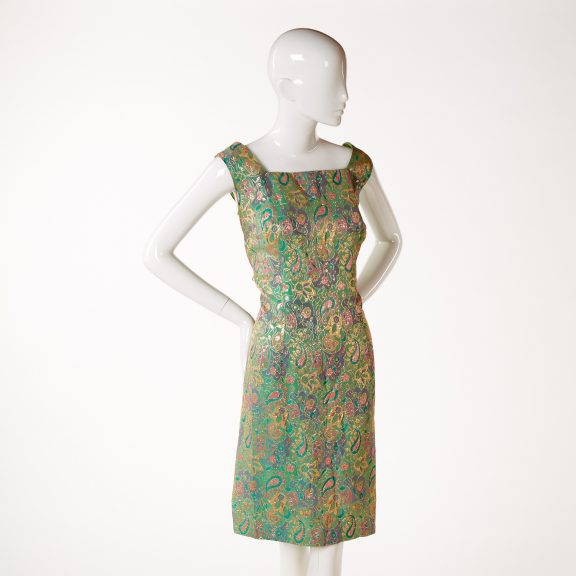
1960s shift dress
Date: 1960s
Object number: 2000.205.31
Designer: Berbright
This shift style evening dress was sold at Krafchik in the 1960s although it never actually found a buyer! Krafchik was a Preston boutique established in 1918 by Polish emigrants Nettie and Benjamin Krafchick on Cannon Street. The couple were originally from Konin in Poland. In 1977 Krafchik was closed and the unsold stock came to the Harris to add to the collection.
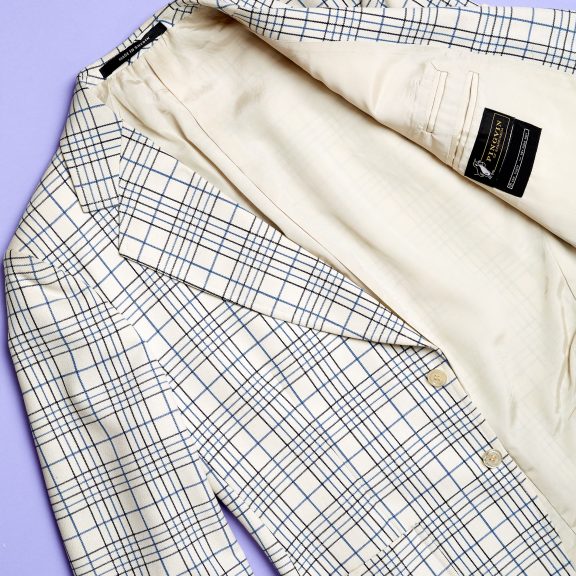
Plaid jacket
Date: 1970-1980
Object number: 1993.119
With its £25 price tag still attached, this 1970s men’s plaid jacket has sadly never been worn. It was unsold stock from Carley’s Menswear, a shop based in St George’s Shopping Centre until the 1990s. The owner ran a number of fashion businesses across the North West including shops Fashion Pie and Sid’s.
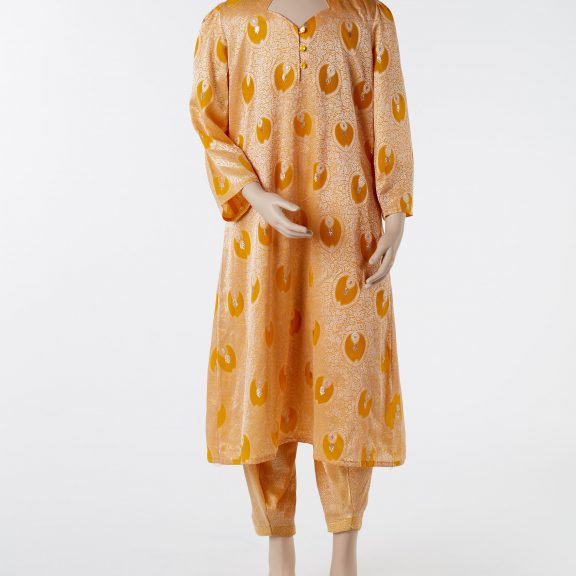
Orange shalwar kameez
Date: 1980- 1994
Object number: 1994.138
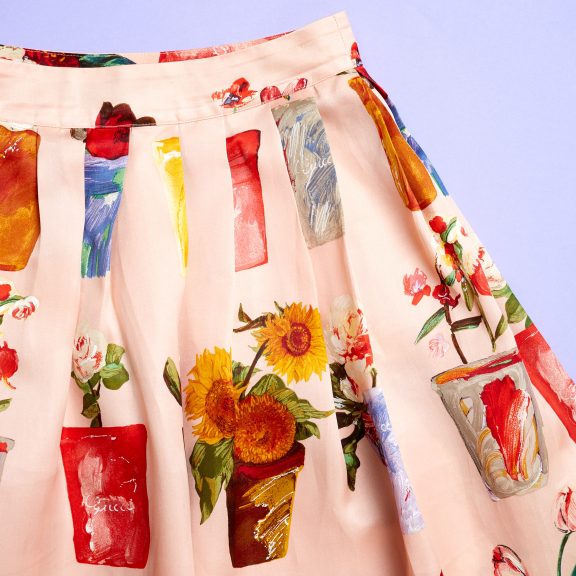
Gucci pink silk skirt
Made: Italy
Date: 1990s
Object number: 2004.44.1
Designer: Gucci
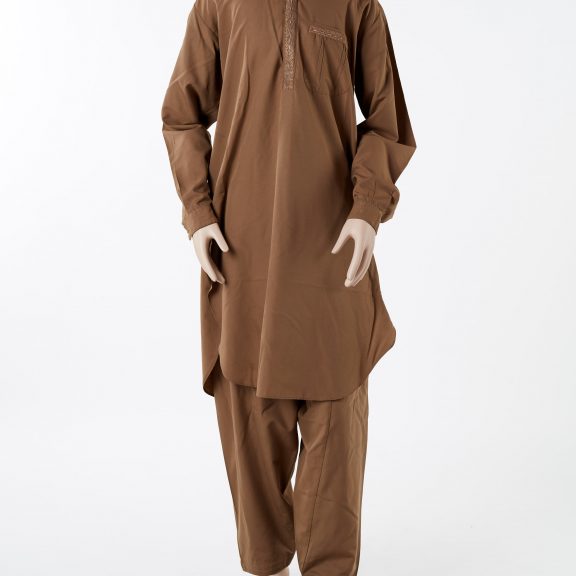
Khaki pathani suit
Date: 1990s
Object number: 1994.205
This khaki embroidered Pathani suit is a type worn by men in Pakistan, Northern India and Kashmir. The name originates from a region known as Pakhtunistan or Pathanistan, which crosses the border between northern Pakistan and Afghanistan. This suit was purchased from Bangees Fashion in Preston and was worn by the donor’s husband on formal occasions in the 1990s. He wore it to events such as visits to the mosque and during Eid celebrations.
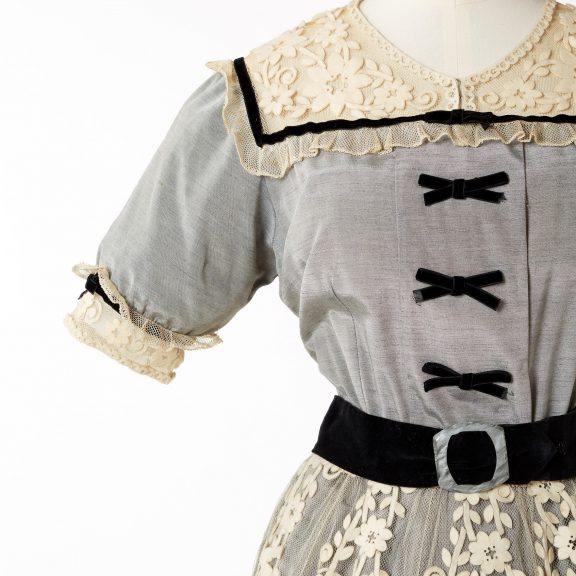
Fuzzy Felts grey dress
Date: 1950 - 1960
Object number: 1982.37
Fuzzy Felt was a popular toy from the 1950s for children, but Caroline from Frenchwood Knoll also used the shapes on her clothes! She added the fuzzy felts to this lovely grey dress with puff sleeves to create a floral design. This is one of over 30 examples of felt-decorated clothes made by the donor that she donated to the Harris. She also painted a self-portrait of herself wearing this felted frock!
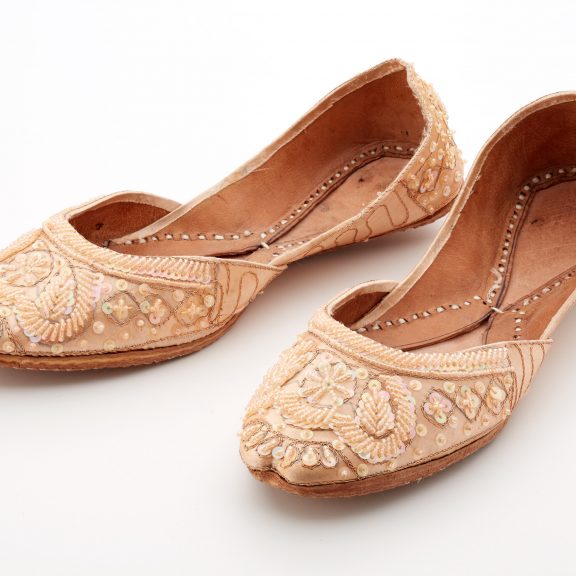
Pink beaded shoes
Object number: 2008.106
These pink beaded shoes with a leather sole were purchased from ‘Marhaba: Magical World of Fashion’ in Deepdale Preston. This type of shoe is known as mojari or khussa, which is a style of footwear in South Asia. They were chosen by a group of local South Asian women as part of community project in 2008. They picked them because they were a good example of what a young British Asian girl would wear with skinny jeans and a kaftan.
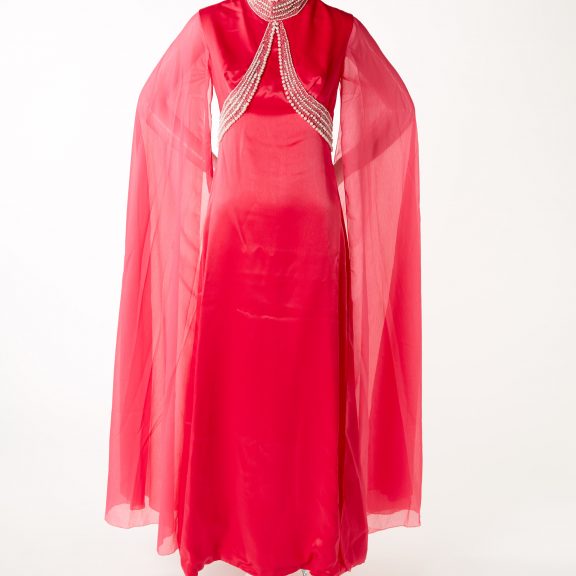
Susan Small pink silk evening dress
Made: England
Object number: 2014.19
Designer: Susan Small
This eye-catching pink silk evening gown with pearl beading around the neck was made by the label Susan Small. The donor bought the dress in Speights on Friargate in Preston to wear during the 1972 Preston Guild. She wore it to a party at the Bull and Royal on Church Street where she apparently stole the show! She never wore the dress again but as it was so special she decided to keep it stored above her wardrobe for 42 years.
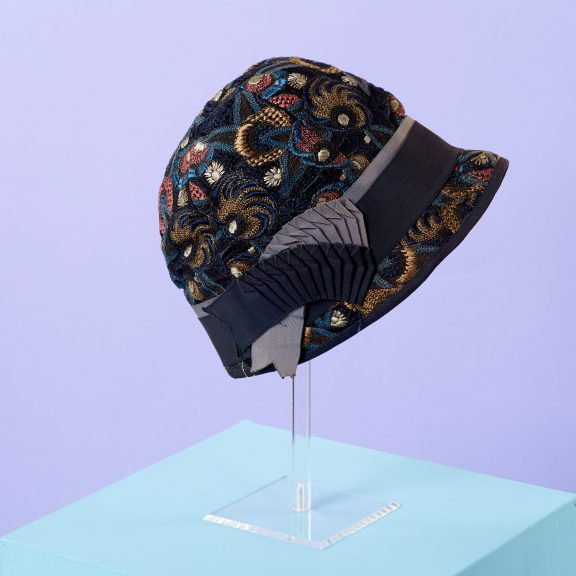
Embroidered cloche hat
Date: 1920s
Object number: 1999.86.1
Embroidered with an all over floral pattern in pink, blue, navy, gold and cream, this cloche hat trimmed with ribbon is from the 1920s. It was worn by the donor’s grandmother Jane Merigold when she was in her sixties. When she was young she worked in a local mill before later marrying Albert Merigold. He was a well-known car dealer, toyshop owner and sports outfitter. The Merigold Brothers also opened Preston’s first cinema – ‘The Embee’.
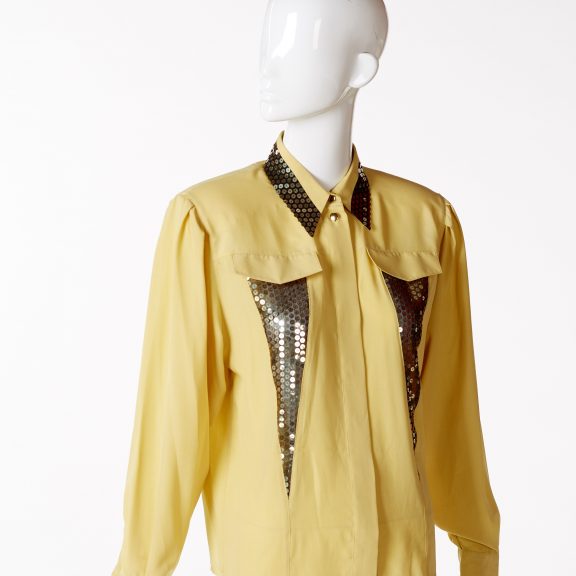
Yellow 80s blouse
Made: Germany
Date: 1987-89
Object number: 1999.100
Designer: Sommermann
Worn by the donor in the 1980s, this mustard yellow long sleeve evening blouse with appliqued panels of black net and gold sequins was bought at Wynn’s on Fylde Road for around £40. The donor wore the shirt when she was in her mid thirties with a long black skirt or trousers, gold earrings and a black handbag with a gold chain. She rarely worn the blouse as she didn’t think the colour suited her but as it was expensive she decided to keep it rather than give it away at the time.
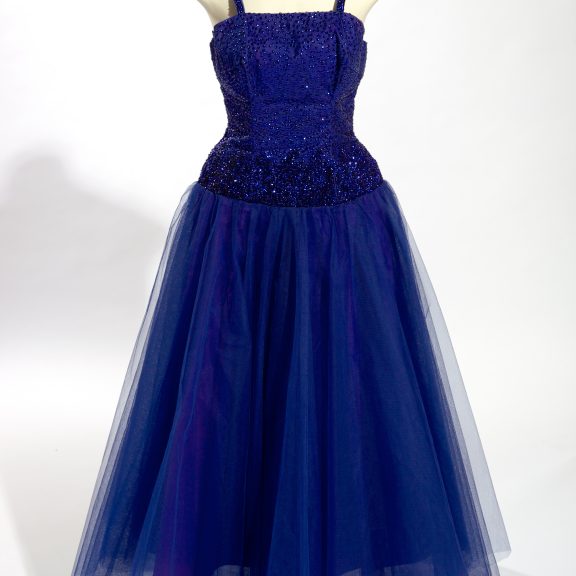
Blue sequin and tulle evening dress
Made: London
Date: 1970
Object number: 1999.15.1a
Designer: Rebuck
This dark blue sequin and tulle evening dress was purchased from Nottingham House, one of the poshest dress shops in Preston. It was worn by the donor to a Masonic Ladies night in a Blackpool hotel in 1970 with a fur stole and matching shoes and handbag. These events were formal dress only and were held annually to thank the ladies for their support throughout the year. The day would involve dancing, entertainment, food and drink until midnight and finished with bacon and eggs and ice cream!
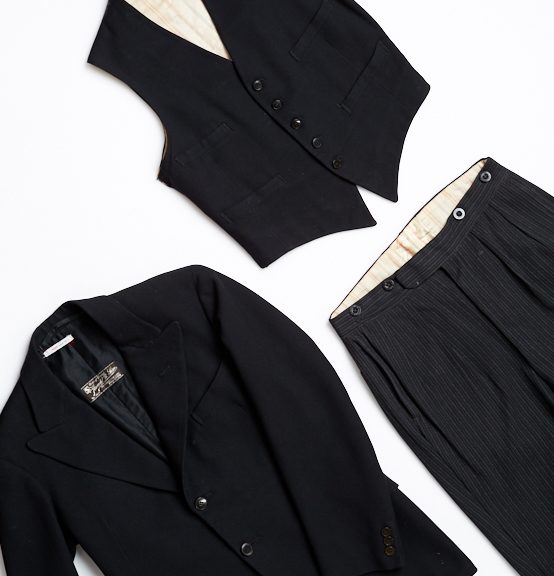
Harold B. Sim black wool suit
Made: Preston
Date: 1920s
Object number: 2004.18.1-3
Designer: Harold B. Sim
Local tailor Harold B. Sim of Ribbleton Lane made this black wool pinstripe suit in the 1920s. It was purchased by Anthony Conway to wear as his Sunday best. Anthony was a slater whose jobs in the area included St Walburge’s church spire. He and his wife Ruth lived on High Street – which is where the Ring Way is now.
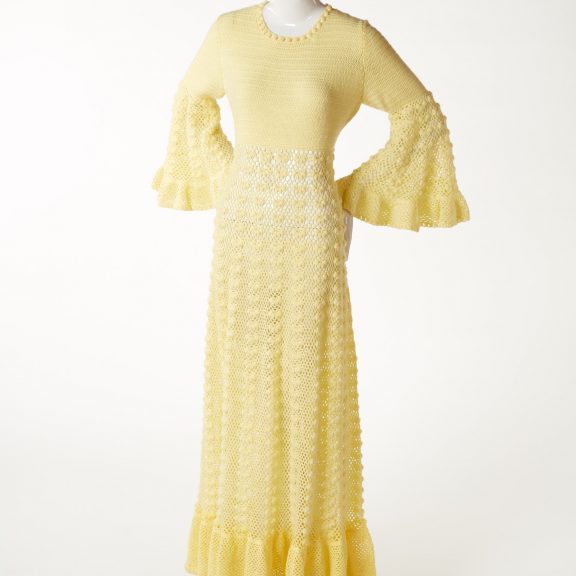
Yellow crocheted evening dress
Made: Preston
Date: 1962
Object number: 1999.78
This striking yellow hand-crocheted evening dress with pagoda sleeves was made by Bernie Barmby in 1962 with wool from Coupes in Preston. The dress was worn with a separate full length yellow cotton underskirt and light stockings. She accessorised the dress with a pair of gold high heels, long gold earrings and gold gloves flecked with yellow. A strong look!
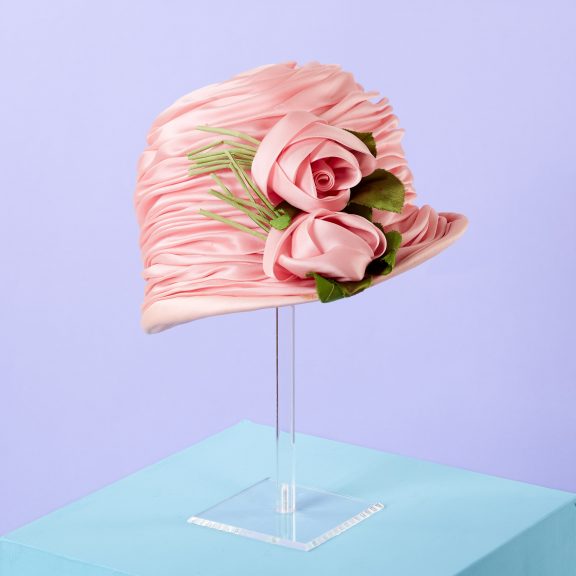
Edna Deakin pink hat
Made: Preston
Date: 1960s
Object number: 2008.149
Designer: Edna Deakin
This pink ruched bonnet-style hat was bought in 1966 from Edna Deakin’s shop. Edna was a well-known hat maker based on Church Street between 1938 and 1983. Her shop stayed open during the war (as hats weren’t rationed) and only closed when Church Street was redeveloped by the council. The hat was purchased for the donors wedding by her mother and it became her favourite, she wore the hat to many more weddings and events!
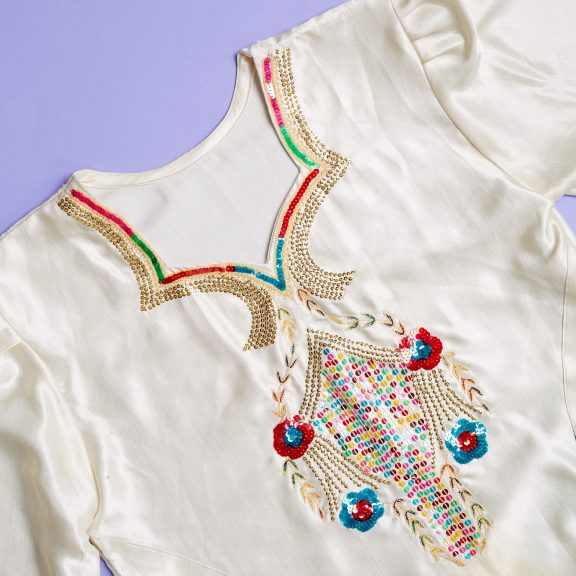
White satin shalwar kameez
Date: 1995
Object number: tc1460
A little glitter goes a long way on this white satin shalwar kameez embroidered with multi coloured beads and silks. Mrs Patel from Deepdale donated this outfit to the Harris in the 1990s, along with several examples of men’s and women’s clothing. Mrs Patel often shopped at Bangee Fabrics in Preston – which is still trading on Argyll Road.
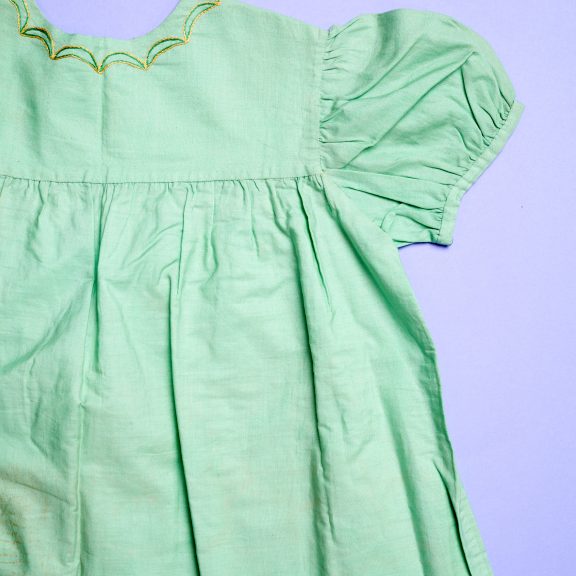
Child’s green dress
Made: Preston
Date: 1953
This green child’s cotton dress has a high waist, full skirt, short puffed sleeves and an embroidered neck with a simple pattern of semi-circles in yellow and green silks. The dress came from a draper’s shop owned by Agnes Cookson at 218 Plungington Road. The shop closed down in 1953 and the dress was part of a collection of unsold stock that was donated to the Harris.
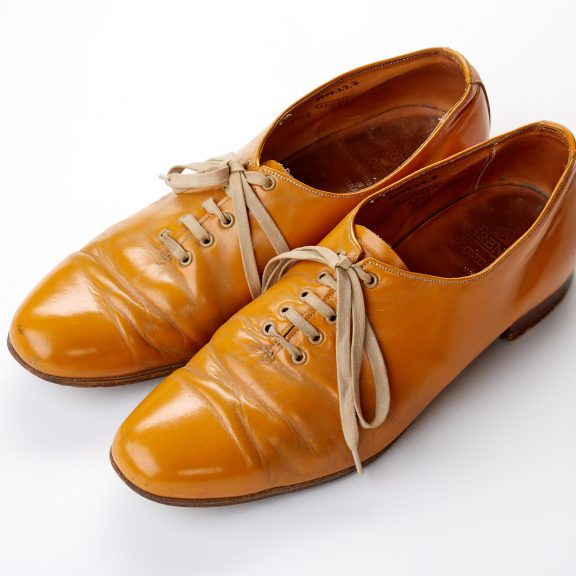
Mustard leather shoes
Made: England
Date: 1977
Object number: 2007.27.7
Designer: Grenson
This pair of size 8 men’s mustard leather with cream lace shoes were made by Grenson, a British shoe brand. They were bought by the donor in 1977 from Wardrobe, a quality menswear shop in Miller Arcade, Preston. The donor was a big fan of Northern Soul music and went to many club nights across the North West. These wellworn shoes must have seen some vigorous dancing on his nights out!
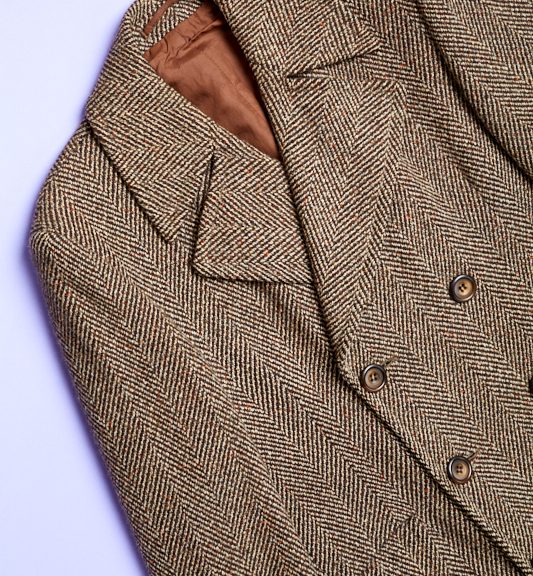
Gentleman’s wool herringbone overcoat
Date: 1973
Object number: 2000.227
Designer: Burton
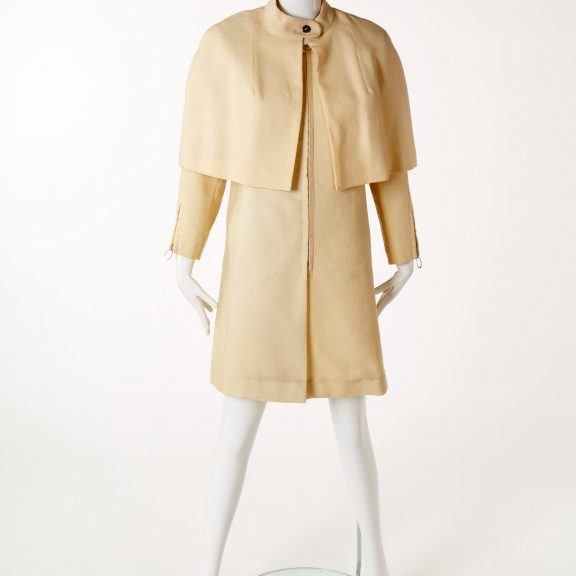
Mary Quant matching dress and cape
Date: 1966-68
Object number: 1980.11
Designer: Mary Quant Ginger Group
This is a matching cream wool long sleeved coat and cape by Mary Quant’s diffusion Ginger Group label. Few staff at the Harris can claim to be fashion leaders however this was worn in the museum in the 1970s by curator Gillian Tressider. After leaving the museum she donated a number of her fashionable clothes to the Harris to add to the fashion collection!
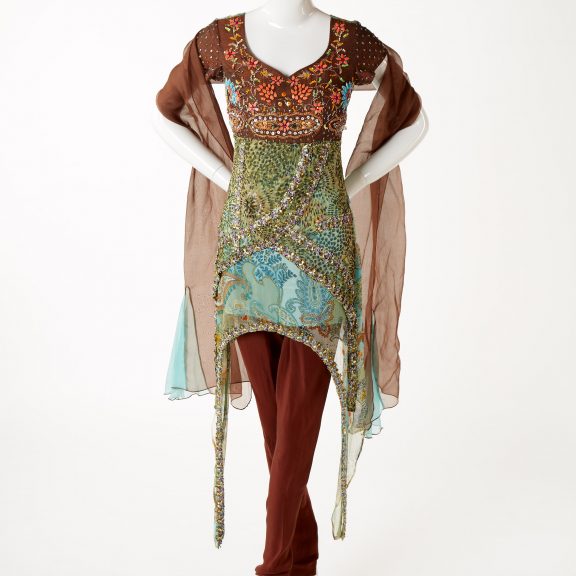
Ladies kameez and churidar
Date: 2008
Object number: 2008.15
This outfit is a classic kameez (long shirt or tunic) with tightly fitting trousers known as churidar. In 2008 the Harris worked with museum trainee Mezhebin Adam to choose a new outfit for the Harris collection. This was purchased by the museum from a shop in Ribbleton as an example of something a young South Asian woman in Preston would wear to a wedding or party
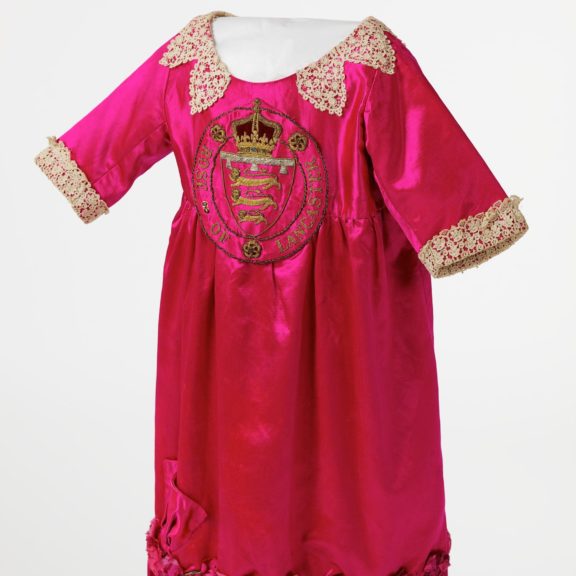
Fancy dress outfit in red silk ‘Rose of Lancaster’
Made: Simpson family of Preston
Date: 1922
Object number: 1974.121
A unique feature of the Harris’s collection are clothes worn to Preston Guild events, and commemorative textiles made to mark this special occasion. The Preston Guild is an ancient civic celebration which takes place every 20 years. Taking place over a week in September, the festivities traditionally include fancy dress balls, pageants and processions on the streets and parks in Preston. Dressing up is a special feature of these events and the Harris cares for many Preston Guild outfits – such as this Rose of Lancaster dress worn to the 1922 Preston Guild Fancy Dress ball by Valerie Simpson aged 11. You can see more of the Harris’s fashion and textile collection on Google’s Art & Culture We Wear Culture website.
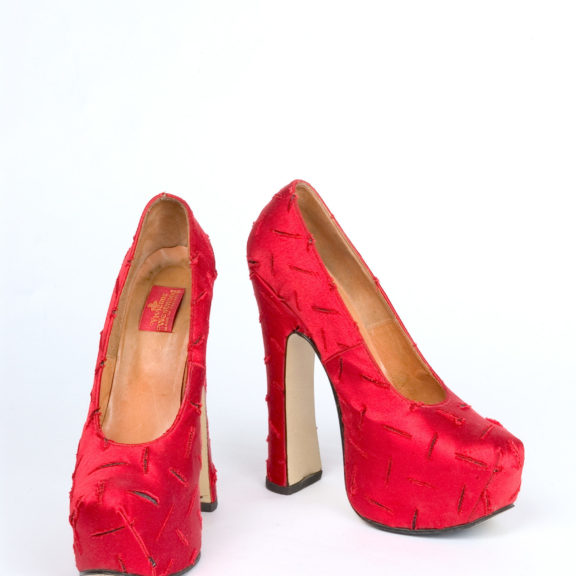
High-heeled platform shoes in slashed red silk
Date: 1991
Object number: 2000.203
Designer: Vivienne Westwood
The shoes were part of Vivienne Westwood’s ‘Cut, Slash and Pull’ collection for Spring/Summer 1991. Supermodel Naomi Campbell famously fell over during a fashion show while wearing a pair of blue Vivienne Westwood platform shoes. Lancashire girls are made of stronger stuff – as the donor of these shores wore them wore for nights out dancing in Preston and Blackpool. The Harris cares a huge variety of fashion accessories, including shoes, hats, handbags, fans, jewellery, hair accessories and purses. You will also find a large collection of historic eyewear including spectacles from the 1700 and 1800s in the collection. You can see more of the Harris’s fashion and textile collection on Google’s Art & Culture We Wear Culture website.
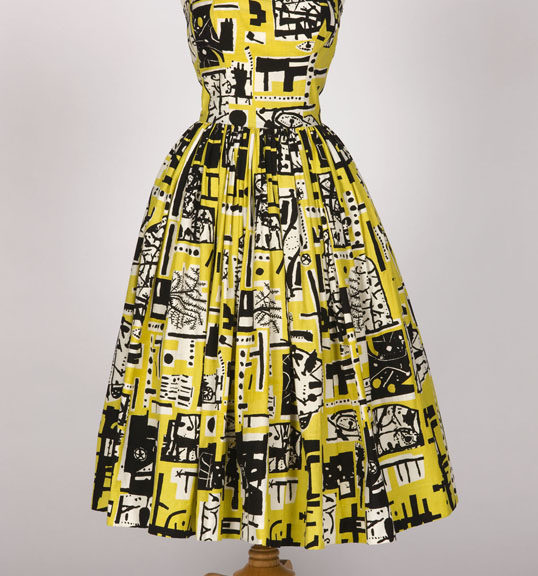
Cocktail dress in black, white and yellow printed cotton
Made: Horrockses Fashions
Date: 1953
Object number: 2003.81
The Harris is very lucky to care for over 60 Horrockses Fashions dresses, along with design books and archival material. Horrockses was a Preston-based cotton firm which launched a range of ready-to-wear frocks in 1946. They were cleverly marketed and appealed to everyone from royalty to everyday women around the world. This example is in a fabric designed by Eduardo Paolozzi. Horrockses Fashions sought patterns from many famous artists of the day including Alistair Morton and Pat Albeck – which all contributed to making this fashion label so popular then and now. You can see more of the Harris’s fashion and textile collection on Google’s Art & Culture We Wear Culture website.
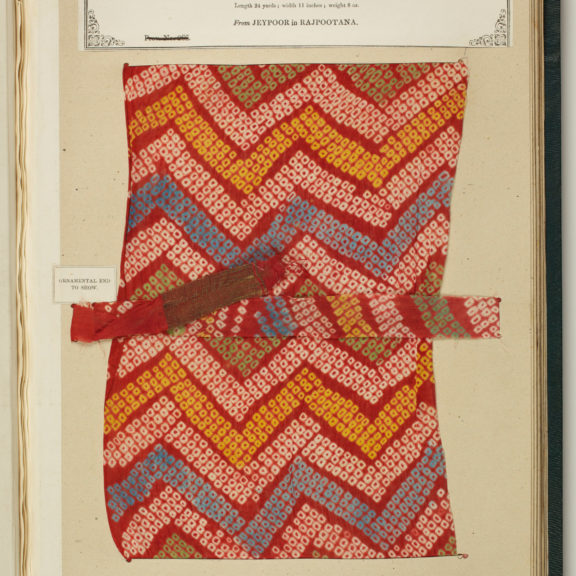
Turban textile sample from The Textile Manufactures of India, volume 1, plate 27
Made: Jaipur, Rajasthan, India
This textile is a very sophisticated example of tie-dying. It is known as bandhani – which comes from the Sanskrit word bandh to bind. Tiny sections of fabric are tightly bound with thread and dip-dyed in stages to create colourful, dotty patterns.
This textile is one of 800 samples from The Textile Manufactures of India – an 18 volume set of books put together in 1866 by John Forbes Watson. Today this collection is admired as a wonderful compendium of South Asian textile heritage. But Forbes Watson’s original aim was more strategic: to show British textile manufacturers the types of fabrics used in South Asia so that UK businesses could sell mass-produced copies to this huge potential market. You can find out more about this story and see all 800 textiles at www.tmoi.org.uk.
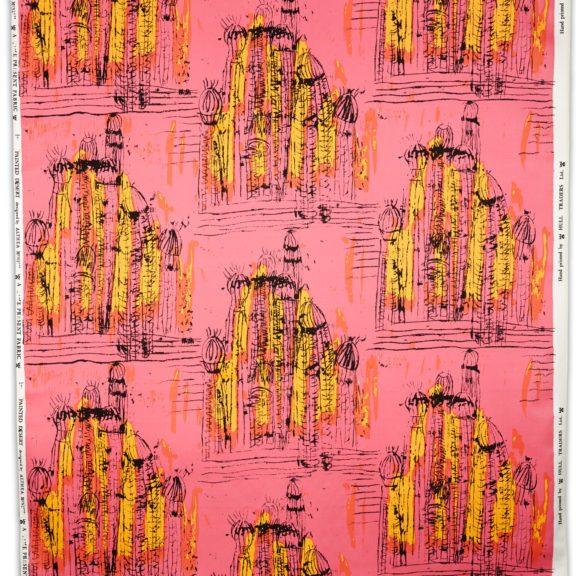
Painted Desert
Made: Hull Traders using a design by Althea McNish
Date: 1961
Object number: 2016.7.2
Painted Desert is a stunning textile designed by Althea McNish – a designer of Trinidadian birth who moved to Britain in the 1950s. McNish has been called one of the first British designers of African descent to gain an international reputation. This design was produced for the Lancashire-based textile firm Hull Traders which specialised in hand-screen-printed textiles in the 1960s. Other artist-designed fabrics in the Harris collection include examples by William Gear, Shirley Craven, John Piper and Hans J. Holzer. Textile art pieces include those by Ann Sutton, Juniichi Arai and Liz Nilsson. You can see more of the Harris’s fashion and textile collection on Google’s Art & Culture We Wear Culture website.
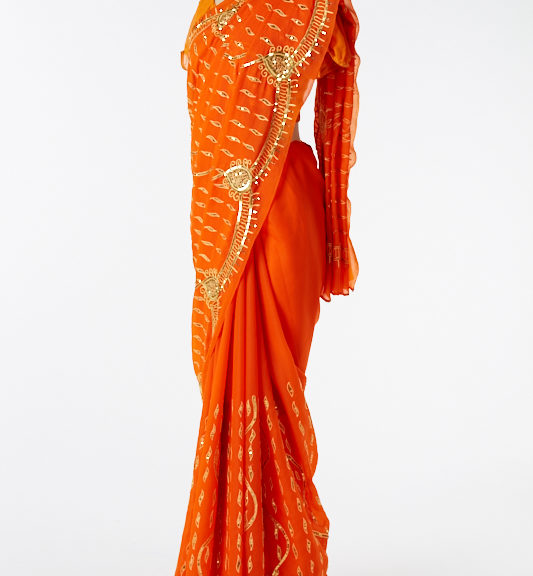
Sari in orange fabric with gold embroidery
Made: Unknown maker
Date: 1980s
Object number: 1994.78
This sari has stunning gold embroidery set against vibrant orange – the pattern is concentrated on the part of the fabric where it would be seen on the body. It was purchased by the donor in Preston in the 1980s and later donated to the Harris. During the 1990s the Harris worked on a number of projects to acquire examples of men, women and children’s clothing from the South Asian communities to represent different styles of dress from across this region. The collection includes saris, shalwar kameez and a wide range of jewellery. You can see more of the Harris’s fashion and textile collection on Google’s Art & Culture We Wear Culture website.
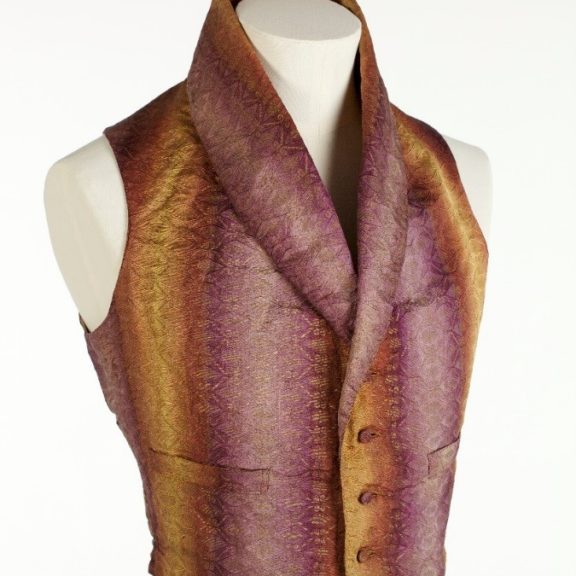
Waistcoat in tones of purple and orange silk
Made: Unknown maker
Date: 1840
Object number: c125
This man’s waistcoat is made from a type of fabric known as a fancy silk because it showcases all the fancy effects textile manufacturers could achieve in the mid-1800s – as technology became more sophisticated. Combined with its neatly tailored shape and high collar, the original wearer of this waistcoat must have cut quite a dash. The Harris has examples of men’s clothing and accessories from the 1700s to modern day – but the largest part of the collection is men’s waistcoats from the 1800s. You can see more of the Harris’s fashion and textile collection on Google’s Art & Culture We Wear Culture website.
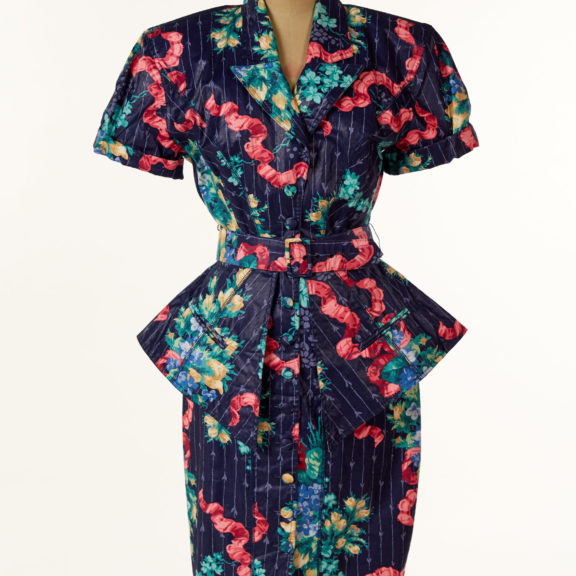
Dress in navy blue cotton with ribbon and flower pattern
Designer: Karen Alexander
This dress with fabulous big 1980s shoulder pads was worn by the donor to her wedding at Preston Registry Office. The Harris currently concentrates on collecting examples of post-1950s fashions. We also try to collect personal stories about where an outfit was worn, how it felt to wear it, along with photographs of the wearer at the time. Star items in our collection of 1900s clothing includes a large collection of utility underwear, Horrockses Fashions frocks and the famous yellow dress worn by Pauline in the painting by Sir James Gunn of 1944. You can see more of the Harris’s fashion and textile collection on Google’s Art & Culture We Wear Culture website.
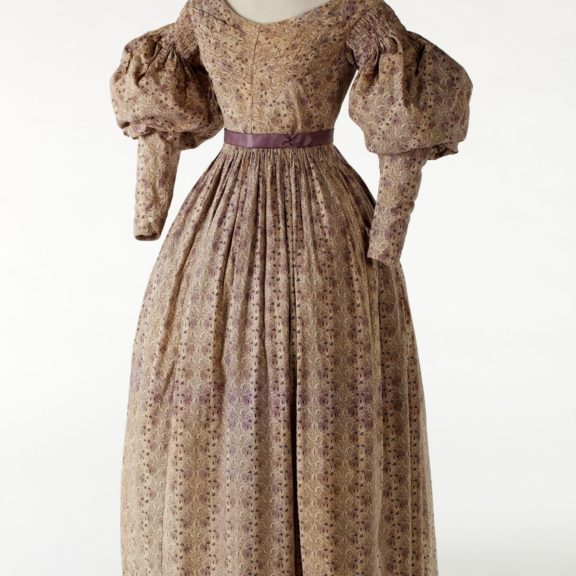
Dress in purple printed cotton with large sleeves
Made: Unknown maker, but from fine woven cotton spun in Lancashire
Date: 1827-38
Object number: co128
The greatest part of the Harris’s fashion collection is made up of women’s clothes from the 1800s. The collection starts with several interesting cotton dresses from the 1820s in fine Lancashire cottons – like this example in shades of purple. In addition to fashionable clothes worn by well-to-do women in every decade of the Victorian age, you will find foundation garments such as underwear, hoops and bustles, and accessories. The Harris also cares for a collection of farmworkers clothing called the Fairclough Collection which straddles the period 1890 to 1950. You can see more of the Harris’s fashion and textile collection on Google’s Art & Culture We Wear Culture website.
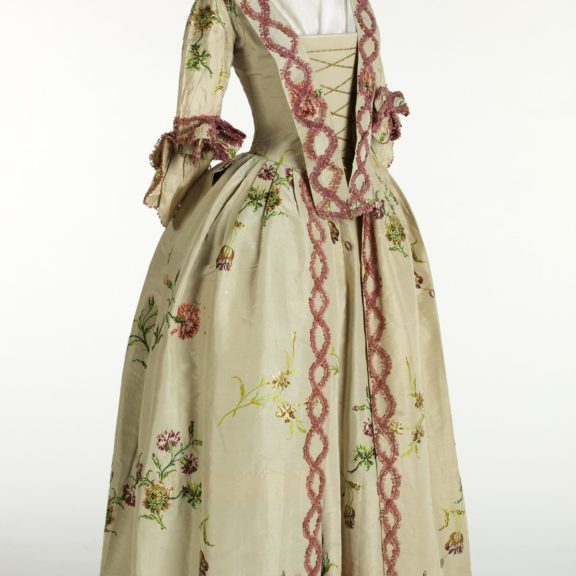
Robe and Skirt in Spitalfields Silk
Made: Unknown maker, silk possibly designed by Anna Maria Garthwaite
Date: 1740s-1760s
Object number: co429
The design of this floral silk is typical of the 1740s, but the style of the outfit reflects 1760s fashions. It was typical for clothes in expensive materials like silk to be unpicked and re-sewn into more fashionable styles. Most of the Harris’s fashion collection dates from the 1800s but we have significant examples of earlier clothing. Alongside this Spitalfields silk dress these include a pair of men’s red embroidered slippers from the 1620s and men’s clothing from the 1700s. You can see more of the Harris’s fashion and textile collection on Google’s Art & Culture We Wear Culture website.
